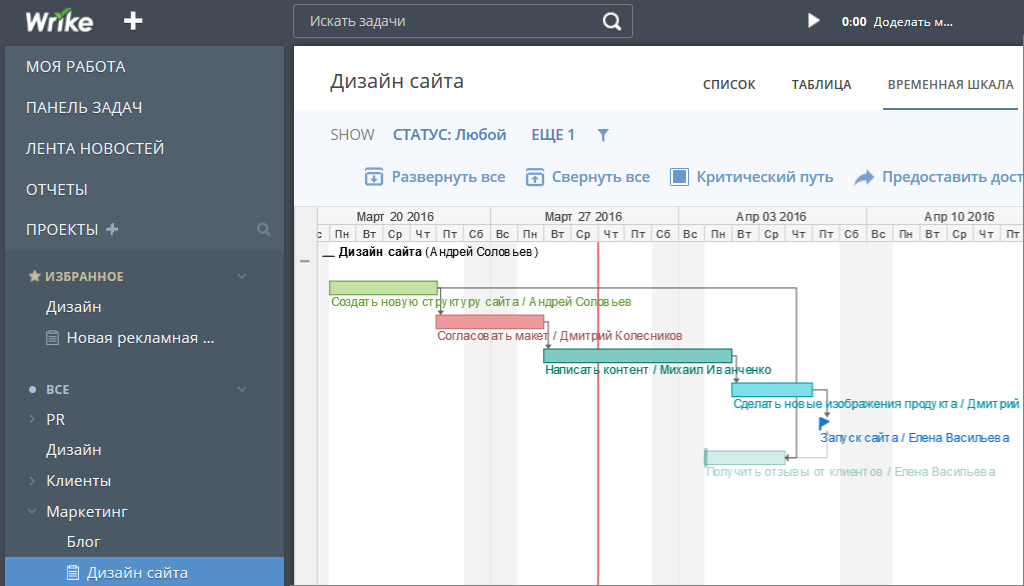How to create realistic plans: recommendations of the Institute for Project Management
Project management theorists say that up to 78% of projects are not executed on time, or go beyond the budget. Anyone who has experienced delays in the project and a deadline failure will immediately identify the likely causes. These are poorly defined project goals, unrealistic deadlines, lack of resources and inefficient team communication.

Indirectly, this is confirmed by the results of our recent survey among office workers. 41% of respondents indicated that when working on a project, the deadlines for completing tasks change “often” or “always.” At the same time, among those who do not use a single repository for work information, this proportion rises to 56%.
It turns out that successful project management is based on two principles. First, we need a well thought-out project plan at the preparatory stage. Secondly, it is important to establish communication in a team in real time while working on a project. This will allow to update the schedule of work and redistribute resources.
')
Cloud services for project management will help with the second (we, of course, recommend Wrike ). They will significantly simplify the process, especially when it comes to a geographically distributed or remote team. People will have instant access to the current working context and will always be up to date with updates, no matter where employees are physically located. At the same time, the manager will have at his disposal such tools as an interactive Gantt chart, creating dependencies between tasks, viewing a critical project path, a basic plan schedule and staff load and other opportunities to simplify life and get a clear picture of what is happening.

As for planning, we found interesting recommendations from the American Project Management Institute , which took root in Wrike and, we hope, will be useful to you too.
At the stage of preparation for the project:
1. Define the objectives and requirements for the project, coordinating them with all interested employees. It is better that this information be documented in detail to avoid possible misunderstandings.
2. If you have already performed similar projects in the past, use them as templates: in the project management system you can simply copy the schedule of the previous project and make the necessary changes to it on the timeline.
3. Ask the task executors to estimate their deadlines Thus, they will not only establish more realistic deadlines based on their experience, but will also feel greater responsibility for their observance than for the deadlines imposed on them from above.
4. Plan tasks with a high risk of being overdue closer to the beginning of the project: for example, tasks that require the participation of other persons (suppliers, experts, etc.) who are not dependent on you. Such planning will increase the likelihood that you will have time to complete them before the end of the entire project.
5. Break up large tasks into short clear steps, preferably with one person in charge so that it is easier to evaluate the progress of the work.

At the stage of project implementation:
1. Determine the critical path of the project. This is the longest chain of dependent tasks, the offset of which will lead to a failure of the timing of the entire project. Watch first of all for timely movement along this path. Tasks that are not included in the critical path, if necessary, can be transferred smoothly for the entire project.

2. Follow the schedule for downloading artists. If they are working on several projects at the same time, your tasks may be in jeopardy. We use a projected load schedule that highlights areas where employees work on two or more tasks in orange. Having found such areas, it is possible to transfer or reassign some tasks in time to avoid overloads.

3. At the beginning of the project, create a baseline schedule so that, in the process of execution, keep track of how real deadlines have shifted. This will help you to adjust the planning of subsequent projects.

4. Timely display all changes in the project graph on the Gantt chart. It should be available to all team members so that they have an understanding of the state of affairs on the entire project, and not just their part of the work.
5. Try to reduce the number of meetings on the progress of the work and transfer the exchange of information about the project online. According to the results of our survey, half of the employees take part in 2-5 meetings per week, and for 34% of them the number of weekly working meetings reaches 6-10. Most of these meetings relate to project status updates and often do not end with a clear formulation of further actions. By transferring the work discussion to the “cloud”, you will, firstly, save a significant portion of the staff’s working time, and, secondly, make the working context accessible to the entire team at once. The need for meetings can be reduced to one meeting a week, or even a month.
If you have additional recommendations on how to ensure the implementation of the project on time, we will be glad to read them in the comments.

Indirectly, this is confirmed by the results of our recent survey among office workers. 41% of respondents indicated that when working on a project, the deadlines for completing tasks change “often” or “always.” At the same time, among those who do not use a single repository for work information, this proportion rises to 56%.
It turns out that successful project management is based on two principles. First, we need a well thought-out project plan at the preparatory stage. Secondly, it is important to establish communication in a team in real time while working on a project. This will allow to update the schedule of work and redistribute resources.
')
Cloud services for project management will help with the second (we, of course, recommend Wrike ). They will significantly simplify the process, especially when it comes to a geographically distributed or remote team. People will have instant access to the current working context and will always be up to date with updates, no matter where employees are physically located. At the same time, the manager will have at his disposal such tools as an interactive Gantt chart, creating dependencies between tasks, viewing a critical project path, a basic plan schedule and staff load and other opportunities to simplify life and get a clear picture of what is happening.

As for planning, we found interesting recommendations from the American Project Management Institute , which took root in Wrike and, we hope, will be useful to you too.
At the stage of preparation for the project:
1. Define the objectives and requirements for the project, coordinating them with all interested employees. It is better that this information be documented in detail to avoid possible misunderstandings.
2. If you have already performed similar projects in the past, use them as templates: in the project management system you can simply copy the schedule of the previous project and make the necessary changes to it on the timeline.
3. Ask the task executors to estimate their deadlines Thus, they will not only establish more realistic deadlines based on their experience, but will also feel greater responsibility for their observance than for the deadlines imposed on them from above.
4. Plan tasks with a high risk of being overdue closer to the beginning of the project: for example, tasks that require the participation of other persons (suppliers, experts, etc.) who are not dependent on you. Such planning will increase the likelihood that you will have time to complete them before the end of the entire project.
5. Break up large tasks into short clear steps, preferably with one person in charge so that it is easier to evaluate the progress of the work.

At the stage of project implementation:
1. Determine the critical path of the project. This is the longest chain of dependent tasks, the offset of which will lead to a failure of the timing of the entire project. Watch first of all for timely movement along this path. Tasks that are not included in the critical path, if necessary, can be transferred smoothly for the entire project.

2. Follow the schedule for downloading artists. If they are working on several projects at the same time, your tasks may be in jeopardy. We use a projected load schedule that highlights areas where employees work on two or more tasks in orange. Having found such areas, it is possible to transfer or reassign some tasks in time to avoid overloads.

3. At the beginning of the project, create a baseline schedule so that, in the process of execution, keep track of how real deadlines have shifted. This will help you to adjust the planning of subsequent projects.

4. Timely display all changes in the project graph on the Gantt chart. It should be available to all team members so that they have an understanding of the state of affairs on the entire project, and not just their part of the work.
5. Try to reduce the number of meetings on the progress of the work and transfer the exchange of information about the project online. According to the results of our survey, half of the employees take part in 2-5 meetings per week, and for 34% of them the number of weekly working meetings reaches 6-10. Most of these meetings relate to project status updates and often do not end with a clear formulation of further actions. By transferring the work discussion to the “cloud”, you will, firstly, save a significant portion of the staff’s working time, and, secondly, make the working context accessible to the entire team at once. The need for meetings can be reduced to one meeting a week, or even a month.
If you have additional recommendations on how to ensure the implementation of the project on time, we will be glad to read them in the comments.
Source: https://habr.com/ru/post/299800/
All Articles